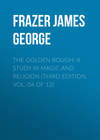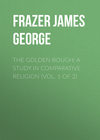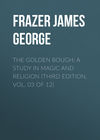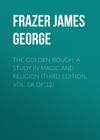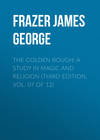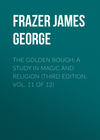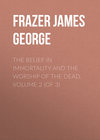Kitabı oku: «The Golden Bough: A Study in Magic and Religion (Third Edition, Vol. 04 of 12)», sayfa 18
§ 6. Bringing in Summer
The custom of carrying out Death is often followed by the ceremony of bringing in Summer, in which the Summer is represented by a tree or branches.
In the preceding ceremonies the return of Spring, Summer, or Life, as a sequel to the expulsion of Death, is only implied or at most announced. In the following ceremonies it is plainly enacted. Thus in some parts of Bohemia the effigy of Death is drowned by being thrown into the water at sunset; then the girls go out into the wood and cut down a young tree with a green crown, hang a doll dressed as a woman on it, deck the whole with green, red, and white ribbons, and march in procession with their Líto (Summer) into the village, collecting gifts and singing —
“Death swims in the water,
Spring comes to visit us,
With eggs that are red,
With yellow pancakes.
We carried Death out of the village,
We are carrying Summer into the village.”670
In many Silesian villages the figure of Death, after being treated with respect, is stript of its clothes and flung with curses into the water, or torn to pieces in a field. Then the young folk repair to a wood, cut down a small fir-tree, peel the trunk, and deck it with festoons of evergreens, paper roses, painted egg-shells, motley bits of cloth, and so forth. The tree thus adorned is called Summer or May. Boys carry it from house to house singing appropriate songs and begging for presents. Among their songs is the following: —
“We have carried Death out,
We are bringing the dear Summer back,
The Summer and the May
And all the flowers gay.”
Sometimes they also bring back from the wood a prettily adorned figure, which goes by the name of Summer, May, or the Bride; in the Polish districts it is called Dziewanna, the goddess of spring.671
At Eisenach on the fourth Sunday in Lent young people used to fasten a straw-man, representing Death, to a wheel, which they trundled to the top of a hill. Then setting fire to the figure they allowed it and the wheel to roll down the slope. Next they cut a tall fir-tree, tricked it out with ribbons, and set it up in the plain. The men then climbed the tree to fetch down the ribbons.672 In Upper Lusatia the figure of Death, made of straw and rags, is dressed in a veil furnished by the last bride and a shirt provided by the house in which the last death took place. Thus arrayed the figure is stuck on the end of a long pole and carried at full speed by the tallest and strongest girl, while the rest pelt the effigy with sticks and stones. Whoever hits it will be sure to live through the year. In this way Death is carried out of the village and thrown into the water or over the boundary of the next village. On their way home each one breaks a green branch and carries it gaily with him till he reaches the village, when he throws it away. Sometimes the young people of the next village, upon whose land the figure has been thrown, run after them and hurl it back, not wishing to have Death among them. Hence the two parties occasionally come to blows.673
New potency of life ascribed to the image of Death. Carrying out Death at Braller in Transylvania.
In these cases Death is represented by the puppet which is thrown away, Summer or Life by the branches or trees which are brought back. But sometimes a new potency of life seems to be attributed to the image of Death itself, and by a kind of resurrection it becomes the instrument of the general revival. Thus in some parts of Lusatia women alone are concerned in carrying out Death, and suffer no male to meddle with it. Attired in mourning, which they wear the whole day, they make a puppet of straw, clothe it in a white shirt, and give it a broom in one hand and a scythe in the other. Singing songs and pursued by urchins throwing stones, they carry the puppet to the village boundary, where they tear it in pieces. Then they cut down a fine tree, hang the shirt on it, and carry it home singing.674 On the Feast of Ascension the Saxons of Braller, a village of Transylvania, not far from Hermannstadt, observe the ceremony of “Carrying out Death” in the following manner. After morning service all the school-girls repair to the house of one of their number, and there dress up the Death. This is done by tying a threshed-out sheaf of corn into a rough semblance of a head and body, while the arms are simulated by a broomstick thrust through it horizontally. The figure is dressed in the holiday attire of a young peasant woman, with a red hood, silver brooches, and a profusion of ribbons at the arms and breast. The girls bustle at their work, for soon the bells will be ringing to vespers, and the Death must be ready in time to be placed at the open window, that all the people may see it on their way to church. When vespers are over, the longed-for moment has come for the first procession with the Death to begin; it is a privilege that belongs to the school-girls alone. Two of the older girls seize the figure by the arms and walk in front: all the rest follow two and two. Boys may take no part in the procession, but they troop after it gazing with open-mouthed admiration at the “beautiful Death.” So the procession goes through all the streets of the village, the girls singing the old hymn that begins —
“Gott mein Vater, deine Liebe
Reicht so weit der Himmel ist,”
to a tune that differs from the ordinary one. When the procession has wound its way through every street, the girls go to another house, and having shut the door against the eager prying crowd of boys who follow at their heels, they strip the Death and pass the naked truss of straw out of the window to the boys, who pounce on it, run out of the village with it without singing, and fling the dilapidated effigy into the neighbouring brook. This done, the second scene of the little drama begins. While the boys were carrying away the Death out of the village, the girls remained in the house, and one of them is now dressed in all the finery which had been worn by the effigy. Thus arrayed she is led in procession through all the streets to the singing of the same hymn as before. When the procession is over they all betake themselves to the house of the girl who played the leading part. Here a feast awaits them from which also the boys are excluded. It is a popular belief that the children may safely begin to eat gooseberries and other fruit after the day on which Death has thus been carried out; for Death, which up to that time lurked especially in gooseberries, is now destroyed. Further, they may now bathe with impunity out of doors.675 Very similar is the ceremony which, down to recent years, was observed in some of the German villages of Moravia. Boys and girls met on the afternoon of the first Sunday after Easter, and together fashioned a puppet of straw to represent Death. Decked with bright-coloured ribbons and cloths, and fastened to the top of a long pole, the effigy was then borne with singing and clamour to the nearest height, where it was stript of its gay attire and thrown or rolled down the slope. One of the girls was next dressed in the gauds taken from the effigy of Death, and with her at its head the procession moved back to the village. In some villages the practice is to bury the effigy in the place that has the most evil reputation of all the country-side: others throw it into running water.676
Life-giving virtue ascribed to the effigy of Death.
In the Lusatian ceremony described above,677 the tree which is brought home after the destruction of the figure of Death is plainly equivalent to the trees or branches which, in the preceding customs, were brought back as representatives of Summer or Life, after Death had been thrown away or destroyed. But the transference of the shirt worn by the effigy of Death to the tree clearly indicates that the tree is a kind of revivification, in a new form, of the destroyed effigy.678 This comes out also in the Transylvanian and Moravian customs: the dressing of a girl in the clothes worn by the Death, and the leading her about the village to the same song which had been sung when the Death was being carried about, shew that she is intended to be a kind of resuscitation of the being whose effigy has just been destroyed. These examples therefore suggest that the Death whose demolition is represented in these ceremonies cannot be regarded as the purely destructive agent which we understand by Death. If the tree which is brought back as an embodiment of the reviving vegetation of spring is clothed in the shirt worn by the Death which has just been destroyed, the object certainly cannot be to check and counteract the revival of vegetation: it can only be to foster and promote it. Therefore the being which has just been destroyed – the so-called Death – must be supposed to be endowed with a vivifying and quickening influence, which it can communicate to the vegetable and even the animal world. This ascription of a life-giving virtue to the figure of Death is put beyond a doubt by the custom, observed in some places, of taking pieces of the straw effigy of Death and placing them in the fields to make the crops grow, or in the manger to make the cattle thrive. Thus in Spachendorf, a village of Austrian Silesia, the figure of Death, made of straw, brushwood, and rags, is carried with wild songs to an open place outside the village and there burned, and while it is burning a general struggle takes place for the pieces, which are pulled out of the flames with bare hands. Each one who secures a fragment of the effigy ties it to a branch of the largest tree in his garden, or buries it in his field, in the belief that this causes the crops to grow better.679 In the Troppau district of Austrian Silesia the straw figure which the boys make on the fourth Sunday in Lent is dressed by the girls in woman's clothes and hung with ribbons, necklace, and garlands. Attached to a long pole it is carried out of the village, followed by a troop of young people of both sexes, who alternately frolic, lament, and sing songs. Arrived at its destination – a field outside the village – the figure is stripped of its clothes and ornaments; then the crowd rushes at it and tears it to bits, scuffling for the fragments. Every one tries to get a wisp of the straw of which the effigy was made, because such a wisp, placed in the manger, is believed to make the cattle thrive.680 Or the straw is put in the hens' nest, it being supposed that this prevents the hens from carrying away their eggs, and makes them brood much better.681 The same attribution of a fertilising power to the figure of Death appears in the belief that if the bearers of the figure, after throwing it away, beat cattle with their sticks, this will render the beasts fat or prolific.682 Perhaps the sticks had been previously used to beat the Death,683 and so had acquired the fertilising power ascribed to the effigy. We have seen, too, that at Leipsic a straw effigy of Death was shewn to young wives to make them fruitful.684
The Summer-tree equivalent to the May-tree. But the Summer-tree is a revival of the image of Death; hence the image of Death must be an embodiment of the spirit of vegetation.
It seems hardly possible to separate from the May-trees the trees or branches which are brought into the village after the destruction of the Death. The bearers who bring them in profess to be bringing in the Summer,685 therefore the trees obviously represent the Summer; indeed in Silesia they are commonly called the Summer or the May,686 and the doll which is sometimes attached to the Summer-tree is a duplicate representative of the Summer, just as the May is sometimes represented at the same time by a May-tree and a May Lady.687 Further, the Summer-trees are adorned like May-trees with ribbons and so on; like May-trees, when large, they are planted in the ground and climbed up; and like May-trees, when small, they are carried from door to door by boys or girls singing songs and collecting money.688 And as if to demonstrate the identity of the two sets of customs the bearers of the Summer-tree sometimes announce that they are bringing in the Summer and the May.689 The customs, therefore, of bringing in the May and bringing in the Summer are essentially the same; and the Summer-tree is merely another form of the May-tree, the only distinction (besides that of name) being in the time at which they are respectively brought in; for while the May-tree is usually fetched in on the first of May or at Whitsuntide, the Summer-tree is fetched in on the fourth Sunday in Lent. Therefore, if the May-tree is an embodiment of the tree-spirit or spirit of vegetation, the Summer-tree must likewise be an embodiment of the tree-spirit or spirit of vegetation. But we have seen that the Summer-tree is in some cases a revivification of the effigy of Death. It follows, therefore, that in these cases the effigy called Death must be an embodiment of the tree-spirit or spirit of vegetation. This inference is confirmed, first, by the vivifying and fertilising influence which the fragments of the effigy of Death are believed to exercise both on vegetable and on animal life;690 for this influence, as we saw in the first part of this work,691 is supposed to be a special attribute of the tree-spirit. It is confirmed, secondly, by observing that the effigy of Death is sometimes decked with leaves or made of twigs, branches, hemp, or a threshed-out sheaf of corn;692 and that sometimes it is hung on a little tree and so carried about by girls collecting money,693 just as is done with the May-tree and the May Lady, and with the Summer-tree and the doll attached to it. In short we are driven to regard the expulsion of Death and the bringing in of Summer as, in some cases at least, merely another form of that death and revival of the spirit of vegetation in spring which we saw enacted in the killing and resurrection of the Wild Man.694 The burial and resurrection of the Carnival is probably another way of expressing the same idea. The interment of the representative of the Carnival under a dung-heap695 is natural, if he is supposed to possess a quickening and fertilising influence like that ascribed to the effigy of Death. The Esthonians, indeed, who carry the straw figure out of the village in the usual way on Shrove Tuesday, do not call it the Carnival, but the Wood-spirit (Metsik), and they clearly indicate the identity of the effigy with the wood-spirit by fixing it to the top of a tree in the wood, where it remains for a year, and is besought almost daily with prayers and offerings to protect the herds; for like a true wood-spirit the Metsik is a patron of cattle. Sometimes the Metsik is made of sheaves of corn.696
The names of Carnival, Death, and Summer in the preceding customs seem to cover an ancient tree-spirit or spirit of vegetation.
Thus we may fairly conjecture that the names Carnival, Death, and Summer are comparatively late and inadequate expressions for the beings personified or embodied in the customs with which we have been dealing. The very abstractness of the names bespeaks a modern origin; for the personification of times and seasons like the Carnival and Summer, or of an abstract notion like death, is hardly primitive. But the ceremonies themselves bear the stamp of a dateless antiquity; therefore we can hardly help supposing that in their origin the ideas which they embodied were of a more simple and concrete order. The notion of a tree, perhaps of a particular kind of tree (for some savages have no word for tree in general), or even of an individual tree, is sufficiently concrete to supply a basis from which by a gradual process of generalisation the wider idea of a spirit of vegetation might be reached. But this general idea of vegetation would readily be confounded with the season in which it manifests itself; hence the substitution of Spring, Summer, or May for the tree-spirit or spirit of vegetation would be easy and natural. Again, the concrete notion of the dying tree or dying vegetation would by a similar process of generalisation glide into a notion of death in general; so that the practice of carrying out the dying or dead vegetation in spring, as a preliminary to its revival, would in time widen out into an attempt to banish Death in general from the village or district. The view that in these spring ceremonies Death meant originally the dying or dead vegetation of winter has the high support of W. Mannhardt; and he confirms it by the analogy of the name Death as applied to the spirit of the ripe corn. Commonly the spirit of the ripe corn is conceived, not as dead, but as old, and hence it goes by the name of the Old Man or the Old Woman. But in some places the last sheaf cut at harvest, which is generally believed to be the seat of the corn spirit, is called "the Dead One": children are warned against entering the corn-fields because Death sits in the corn; and, in a game played by Saxon children in Transylvania at the maize harvest, Death is represented by a child completely covered with maize leaves.697
§ 7. Battle of Summer and Winter
Dramatic contests between representatives of Summer and Winter.
Sometimes in the popular customs of the peasantry the contrast between the dormant powers of vegetation in winter and their awakening vitality in spring takes the form of a dramatic contest between actors who play the parts respectively of Winter and Summer. Thus in the towns of Sweden on May Day two troops of young men on horseback used to meet as if for mortal combat. One of them was led by a representative of Winter clad in furs, who threw snowballs and ice in order to prolong the cold weather. The other troop was commanded by a representative of Summer covered with fresh leaves and flowers. In the sham fight which followed the party of Summer came off victorious, and the ceremony ended with a feast.698 Again, in the region of the middle Rhine, a representative of Summer clad in ivy combats a representative of Winter clad in straw or moss and finally gains a victory over him. The vanquished foe is thrown to the ground and stripped of his casing of straw, which is torn to pieces and scattered about, while the youthful comrades of the two champions sing a song to commemorate the defeat of Winter by Summer. Afterwards they carry about a summer garland or branch and collect gifts of eggs and bacon from house to house. Sometimes the champion who acts the part of Summer is dressed in leaves and flowers and wears a chaplet of flowers on his head. In the Palatinate this mimic conflict takes place on the fourth Sunday in Lent.699 All over Bavaria the same drama used to be acted on the same day, and it was still kept up in some places down to the middle of the nineteenth century or later. While Summer appeared clad all in green, decked with fluttering ribbons, and carrying a branch in blossom or a little tree hung with apples and pears, Winter was muffled up in cap and mantle of fur and bore in his hand a snow-shovel or a flail. Accompanied by their respective retinues dressed in corresponding attire, they went through all the streets of the village, halting before the houses and singing staves of old songs, for which they received presents of bread, eggs, and fruit. Finally, after a short struggle, Winter was beaten by Summer and ducked in the village well or driven out of the village with shouts and laughter into the forest.700 In some parts of Bavaria the boys who play the parts of Winter and Summer act their little drama in every house that they visit, and engage in a war of words before they come to blows, each of them vaunting the pleasures and benefits of the season he represents and disparaging those of the other. The dialogue is in verse. A few couplets may serve as specimens: —
Summer
“Green, green are meadows wherever I pass
And the mowers are busy among the grass.”
Winter
“White, white are the meadows wherever I go,
And the sledges glide hissing across the snow.”
Summer
“I'll climb up the tree where the red cherries glow,
And Winter can stand by himself down below.”
Winter
“With you I will climb the cherry-tree tall,
Its branches will kindle the fire in the hall.”
Summer
“O Winter, you are most uncivil
To send old women to the devil.”
Winter
“By that I make them warm and mellow,
So let them bawl and let them bellow.”
Summer
“I am the Summer in white array,
I'm chasing the Winter far, far away.”
Winter
“I am the Winter in mantle of furs,
I'm chasing the Summer o'er bushes and burs.”
Summer
“Just say a word more, and I'll have you banned
At once and for ever from Summer land.”
Winter
“O Summer, for all your bluster and brag,
You'd not dare to carry a hen in a bag.”
Summer
“O Winter, your chatter no more can I stay,
I'll kick and I'll cuff you without delay.”
Here ensues a scuffle between the two little boys, in which Summer gets the best of it, and turns Winter out of the house. But soon the beaten champion of Winter peeps in at the door and says with a humbled and crestfallen air: —
“O Summer, dear Summer, I'm under your ban,
For you are the master and I am the man.”
To which Summer replies: —
“'Tis a capital notion, an excellent plan,
If I am the master and you are the man.
So come, my dear Winter, and give me your hand,
We'll travel together to Summer Land.”701
Dramatic contests between representatives of Summer and Winter.
At Goepfritz in Lower Austria, two men personating Summer and Winter used to go from house to house on Shrove Tuesday, and were everywhere welcomed by the children with great delight. The representative of Summer was clad in white and bore a sickle; his comrade, who played the part of Winter, had a fur-cap on his head, his arms and legs were swathed in straw, and he carried a flail. In every house they sang verses alternately.702 At Drömling in Brunswick, down to the present time, the contest between Summer and Winter is acted every year at Whitsuntide by a troop of boys and a troop of girls. The boys rush singing, shouting, and ringing bells from house to house to drive Winter away; after them come the girls singing softly and led by a May Bride, all in bright dresses and decked with flowers and garlands to represent the genial advent of spring. Formerly the part of Winter was played by a straw-man which the boys carried with them; now it is acted by a real man in disguise.703 In Wachtl and Brodek, a German village and a little German town of Moravia, encompassed by Slavonic people on every side, the great change that comes over the earth in spring is still annually mimicked. The long village of Wachtl, with its trim houses and farmyards, nestles in a valley surrounded by pretty pine-woods. Here, on a day in spring, about the time of the vernal equinox, an elderly man with a long flaxen beard may be seen going from door to door. He is muffled in furs, with warm gloves on his hands and a bearskin cap on his head, and he carries a threshing flail. This is the personification of Winter. With him goes a younger beardless man dressed in white, wearing a straw hat trimmed with gay ribbons on his head, and carrying a decorated May-tree in his hands. This is Summer. At every house they receive a friendly greeting and recite a long dialogue in verse, Winter punctuating his discourse with his flail, which he brings down with rude vigour on the backs of all within reach.704 Amongst the Slavonic population near Ungarisch Brod, in Moravia, the ceremony took a somewhat different form. Girls dressed in green marched in procession round a May-tree. Then two others, one in white and one in green, stepped up to the tree and engaged in a dialogue. Finally, the girl in white was driven away, but returned afterwards clothed in green, and the festival ended with a dance.705
Queen of Winter and Queen of May in the Isle of Man.
On May Day it used to be customary in almost all the large parishes of the Isle of Man to choose from among the daughters of the wealthiest farmers a young maiden to be Queen of May. She was dressed in the gayest attire and attended by about twenty others, who were called maids of honour. She had also a young man for her captain with a number of inferior officers under him. In opposition to her was the Queen of Winter, a man attired as a woman, with woollen hoods, fur tippets, and loaded with the warmest and heaviest clothes, one upon another. Her attendants were habited in like manner, and she too had a captain and troop for her defence. Thus representing respectively the beauty of spring and the deformity of winter they set forth from their different quarters, the one preceded by the dulcet music of flutes and violins, the other by the harsh clatter of cleavers and tongs. In this array they marched till they met on a common, where the trains of the two mimic sovereigns engaged in a mock battle. If the Queen of Winter's forces got the better of their adversaries and took her rival prisoner, the captive Queen of Summer was ransomed for as much as would pay the expenses of the festival. After this ceremony, Winter and her company retired and diverted themselves in a barn, while the partisans of Summer danced on the green, concluding the evening with a feast, at which the Queen and her maids sat at one table and the captain and his troop at another. In later times the person of the Queen of May was exempt from capture, but one of her slippers was substituted and, if captured, had to be ransomed to defray the expenses of the pageant. The procession of the Summer, which was subsequently composed of little girls and called the Maceboard, outlived that of its rival the Winter for some years; but both have now long been things of the past.706
Contests between representatives of Summer and Winter among the Esquimaux. Canadian Indians drove away Winter with burning brands.
Among the central Esquimaux of North America the contest between representatives of summer and winter, which in Europe has long degenerated into a mere dramatic performance, is still kept up as a magical ceremony of which the avowed intention is to influence the weather. In autumn, when storms announce the approach of the dismal Arctic winter, the Esquimaux divide themselves into two parties called respectively the ptarmigans and the ducks, the ptarmigans comprising all persons born in winter, and the ducks all persons born in summer. A long rope of sealskin is then stretched out, and each party laying hold of one end of it seeks by tugging with might and main to drag the other party over to its side. If the ptarmigans get the worst of it, then summer has won the game and fine weather may be expected to prevail through the winter.707 In this ceremony it is clearly assumed that persons born in summer have a natural affinity with warm weather, and therefore possess a power of mitigating the rigour of winter, whereas persons born in winter are, so to say, of a cold and frosty disposition and can thereby exert a refrigerating influence on the temperature of the air. In spite of this natural antipathy between the representatives of summer and winter, we may be allowed to conjecture that in the grand tug of war the ptarmigans do not pull at the rope with the same hearty goodwill as the ducks, and that thus the genial influence of summer commonly prevails over the harsh austerity of winter. The Indians of Canada seem also to have imagined that persons are endowed with distinct natural capacities according as they are born in summer or winter, and they turned the distinction to account in much the same fashion as the Esquimaux. When they wearied of the long frosts and the deep snow which kept them prisoners in their huts and prevented them from hunting, all of them who were born in summer rushed out of their houses armed with burning brands and torches which they hurled against the One who makes Winter; and this was supposed to produce the desired effect of mitigating the cold. But those Indians who were born in winter abstained from taking part in the ceremony, for they believed that if they meddled with it the cold would increase instead of diminishing.708 We may surmise that in the corresponding European ceremonies, which have just been described, it was formerly deemed necessary that the actors, who played the parts of Winter and Summer, should have been born in the seasons which they personated.
The burning of Winter at Zurich.
Every year on the Monday after the spring equinox boys and girls attired in gay costume flock at a very early hour into Zurich from the country. The girls, generally clad in white, are called Mareielis and carry two and two a small May tree or a wreath decked with flowers and ribbons. Thus they go in bands from house to house, jingling the bells which are attached to the wreath and singing a song, in which it is said that the Mareielis dance because the leaves and the grass are green and everything is bursting into blossom. In this way they are supposed to celebrate the triumph of Summer and to proclaim his coming. The boys are called Böggen. They generally wear over their ordinary clothes a shirt decked with many-coloured ribbons, tall pointed paper caps on their heads, and masks before their faces. In this quaint costume they cart about through the streets effigies made of straw and other combustible materials which are supposed to represent Winter. At evening these effigies are burned in various parts of the city.709 The ceremony was witnessed at Zurich on Monday, April 20th, 1903, by my friend Dr. J. Sutherland Black, who has kindly furnished me with some notes on the subject. The effigy of Winter was a gigantic figure composed in great part, as it seemed, of cotton-wool. This was laid on a huge pyre, about thirty feet high, which had been erected on the Stadthausplatz close to the lake. In presence of a vast concourse of people fire was set to the pyre and all was soon in a blaze, while the town bells rang a joyous peal. As the figure gradually consumed in the flames, the mechanism enclosed in its interior produced a variety of grotesque effects, such as the gushing forth of bowels. At last nothing remained of the effigy but the iron backbone; the crowd slowly dispersed, and the fire brigade set to work to quench the smouldering embers.710 In this ceremony the contest between Summer and Winter is rather implied than expressed, but the significance of the rite is unmistakable.
